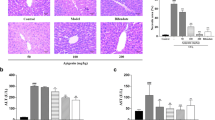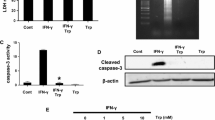Abstract
Objective
To find the signaling pathway of triptolide (TP)-induced liver injury and to reveal whether NF-E2-related factor 2 (Nrf2) plays an important role in cellular self-protection.
Methods
The L-02 and HepG2 cells were cultured and treated with various concentrations of TP. The cell viability was observed, and the cell medium was collected for detecting the aspartate aminotransferase (ALT), alanine aminotransferase (AST), lactate dehydrogenase (LDH), superoxide dismutase (SOD) and L-glutathione production (GSH) levels. Nrf2 and its downstream target NAD(P)H: quinine oxidoreductase 1 (NQO1) and heme oxygenase-1 (HO-1) expression, the nuclear translocation of Nrf2, and the binding ability of Nrf2 and antioxidant response element (ARE) were also identified. Meanwhile, shRNA was used to silence Nrf2 in L-02 cells to find out whether Nrf2 plays a protective role.
Results
The viability of the L-02 and HepG2 cells treated with TP decreased in a doseand time-dependent manner, and TP (20–80 μg/mL) markedly induced the release of ALT, AST and LDH (P<0.05 or P<0.01), reduced the levels of SOD and GSH (P<0.01), and increased the intracellular reactive oxygen species. Meanwhile, TP augmented the Nrf2 expression in L-02 and HepG2 cells (P<0.05 or P<0.01), induced Nrf2 nuclear translocation, increased the Nrf2 ARE binding activity, and increased HO-1 and NQO1 expressions. Nrf2 knockdown revealed a more severe toxic effect of TP (P<0.05 or P<0.01).
Conclusions
Human hepatic cells treated with TP induced oxidative stress, and led to cytotoxicity. Self-protection against TP-induced toxicity in human hepatic cells might be via Nrf2-ARE-NQO1 transcriptional pathway.
Similar content being viewed by others
References
Han R, Rostami-Yazdi M, Gerdes S, Mrowietz U. Triptolide in the treatment of psoriasis and other immunemediated inflammatory diseases. Br J Clin Pharmacol 2012;74:424–436.
Chugh R, Sangwan V, Patil SP, Dudeja V, Dawra RK, Banerjee S, et al. A preclinical evaluation of Minnelide as a therapeutic agent against pancreatic cancer. Sci Transl Med 2012;4:156ra139.
Li XJ, Jiang ZZ, Zhang LY. Triptolide: progress on research in pharmacodynamics and toxicology. J Ethnopharmacol 2014;155:67–79.
Leuenroth SJ, Okuhara D, Shotwell JD, Markowitz GS, Yu Z, Somlo S, et al. Triptolide is a traditional Chinese medicinederived inhibitor of polycystic kidney disease. Proc Natl Acad Sci USA 2007;104:4389–4394.
Fu Q, Jiang ZZ, Zhang LY. Impairment of triptolide on liver mitochondria in isolated liver mitochondria and HL7702 cell line. Chin J Integr Med 2013;19:683–688.
Fu Q, Huang X, Shu B, Xue M, Zhang P, Wang T, et al. Inhibition of mitochondrial respiratory chain is involved in triptolide-induced liver injury. Fitoterapia 2011;82:1241–1248.
Mei Z, Li X, Wu Q, Hu S, Yang X. The research on the antiinflammatory activity and hepatotoxicity of triptolide-loaded solid lipid nanoparticle. Pharmacol Res 2005;51:345–351.
Yao J, Jiang Z, Duan W, Huang J, Zhang L, Hu L, et al. Involvement of mitochondrial pathway in triptolide-induced cytotoxicity in human normal liver L-02 cells. Biol Pharm Bull 2008;31:592–597.
Kang KW, Lee SJ, Kim SG. Molecular mechanism of Nrf2 activation by oxidative stress. Antioxid Redox Signal 2005;7:1664–1673.
Kwon J, Han E, Bui CB, Shin W, Lee J, Lee S, et al. Assurance of mitochondrial integrity and mammalian longevity by the p62-Keap1-Nrf2-Nqo1 cascade. EMBO Rep 2012;13:150–156.
Yeligar SM, Machida K, Kalra VK. Ethanol-induced HO-1 and NQO1 are differentially regulated by HIF-1alpha and Nrf2 to attenuate inflammatory cytokine expression. J Biol Chem 2010;285:35359–35373.
Rubio V, Zhang J, Valverde M, Rojas E, Shi ZZ. Essential role of Nrf2 in protection against hydroquinone- and benzoquinone-induced cytotoxicity. Toxicol In Vitro 2011;25:521–529.
Li J, Jin J, Li M, Guan C, Wang W, Zhu S, et al. Role of Nrf2 in protection against triptolide-induced toxicity in rat kidney cells. Toxicol Lett 2012;213:194–202.
Movahedian A, Asgary S, Mansoorkhani HS, Keshvari M. Hepatotoxicity effect of some Iranian medicinal herbal formulation on rats. Adv Biomed Res 2014;3:12–16.
Balasubramanian T, Senthilkumar GP, Karthikeyan M, Chatterjee TK. Protective effect of ethyl acetate fraction of stereospermum suaveolens against hepatic oxidative stress in STZ diabetic rats. J Tradit Complement Med 2013;3:175–181.
Wang H, Li X, Chen T, Wang W, Liu Q, Li H, et al. Mechanisms of verapamil-enhanced chemosensitivity of gallbladder cancer cells to platinum drugs: glutathione reduction and MRP1 downregulation. Oncol Rep 2013;29:676–684.
Lee JM, Li J, Johnson DA, Stein TD, Kraft AD, Calkins MJ, et al. Nrf2, a multi-organ protector? FASEB J 2005;19:1061–1066.
Li J, Shen F, Guan C, Wang W, Sun X, Fu X, et al. Activation of Nrf2 protects against triptolide-induced hepatotoxicity. PLoS One 2014;9:e100685.
Hur KY, Kim SH, Choi MA, Williams DR, Lee YH, Kang SW, et al. Protective effects of magnesium lithospermate B against diabetic atherosclerosis via Nrf2-ARE-NQO1 transcriptional pathway. Atherosclerosis 2010;211:69–76.
Tanigawa S, Fujii M, Hou DX. Action of Nrf2 and Keap1 in ARE-mediated NQO1 expression by quercetin. Free Radic Biol Med 2007;42:1690–1703.
Zhu H, Jia Z, Mahaney JE, Ross D, Misra HP, Trush MA, et al. The highly expressed and inducible endogenous NAD(P) H: quinone oxidoreductase 1 in cardiovascular cells acts as a potential superoxide scavenger. Cardiovasc Toxicol 2007;7:202–211.
Siegel D, Gustafson DL, Dehn DL, Han JY, Boonchoong P, Berliner L, et al. NAD(P)H: quinone oxidoreductase 1: role as a superoxide scavenger. Mol Pharmacol 2004;65:1238–1247.
Motohashi H, Yamamoto M. Nrf2-Keap1 defines a physiologically important stress response mechanism. Trends Mol Med 2004;10:549–557.
Author information
Authors and Affiliations
Corresponding author
Additional information
Supported by National Natural Science Foundation of China (No. 81072749, 81573869), National Natural Science Foundation for the Youth of Jiangsu Province (No. BK20140960) and National Natural Science Pre-research of Nanjing University of Chinese Medicine (No. 14XYY01, 14XYY10)
Rights and permissions
About this article
Cite this article
Zhou, Ll., Zhou, C., Liang, Xw. et al. Self-protection against triptolide-induced toxicity in human hepatic cells via Nrf2-ARE-NQO1 pathway. Chin. J. Integr. Med. 23, 929–936 (2017). https://doi.org/10.1007/s11655-017-2546-6
Received:
Published:
Issue Date:
DOI: https://doi.org/10.1007/s11655-017-2546-6




